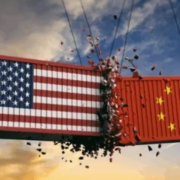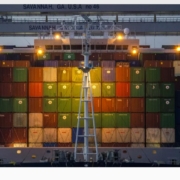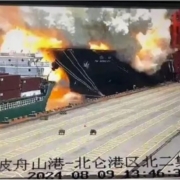Trump’s latest trick could make tariffs more palatable
President Donald Trump’s tariff ambitions have been a tough sell. They’ve put investors in a tizzy, sending financial markets spiraling; cost him the support of many members of his own voter base; and angered CEOs.
Rather than back down and reverse course entirely just a week before Trump’s promised “Liberation Day” on April 2, he’s employing a familiar marketing strategy: Prepare Americans for the worst and deliver something that’s not quite as tough to swallow.
On Monday, Trump did exactly that. “For the most part, April 2 will be a big day,” Trump said, referring to the day he has promised sweeping tariffs against all of America’s trading partners. It’s a subtle change from insisting that it will be the big day involving not just dollar-for-dollar reciprocal tariffs but also sector-wide tariffs. To investors’ glee, Trump even managed to mention doling out carve-outs.
“There definitely has to be a marketing component to this, as the logic behind increased tariffs is not obvious,” Colin Grabow, associate director at the Cato Institute’s Herbert A. Stiefel Center for Trade Policy Studies, told CNN. “My suspicion is that the Trump administration is trying to balance its goals of higher tariffs while not spooking markets too badly.”
Changing the conversation
On Monday, Trump changed the conversation from fears about the economic effects of tariffs to relief that he appeared to be delaying some of those levies.
Auto tariffs, he said, will be announced “very shortly.” Pharmaceutical tariffs: “At some point.” Semiconductor and lumber tariffs: “Down the road.” And on the big, bold reciprocal tariffs, Trump conceded, “I may give a lot of countries breaks.”
“We might be even nicer than that,” Trump added.
As Don Draper, the fictional ad executive in “Mad Men,” told a client concerned about public opinion: “If you don’t like what’s being said, change the conversation.”
This isn’t the first time Trump changed the conversation by presenting a lighter tariff approach compared to prior promises he’s made.
For example, days after Trump was reelected he said, “On January 20th, as one of my many first Executive Orders, I will sign all necessary documents to charge Mexico and Canada a 25% Tariff on ALL products coming into the United States, and its ridiculous Open Borders.” That didn’t happen, however, causing stocks to surge as investors breathed a huge sigh of relief.
Then, the date for those tariffs got pushed back not once but twice. The second delay came after they were briefly enacted and then delayed — but only in part. That meant goods from the two countries are now subject to 25% tariffs if they don’t comply with the terms of the USMCA free trade treaty that Trump signed during his first term. That bit of fine print has largely gone unnoticed.
For China, Trump threatened on the campaign trail to levy tariffs as high as 60% on all Chinese goods coming into the US. As it stands, there’s a 20% tariff on Chinese imports and an additional 25% tariff on steel and aluminum from there.
Mexico, China and Canada are America’s top three trading partners, accounting for 41% of the total value of goods the US imported last year, according to Commerce Department data. That’s why economists and businesses have been fretting about a full-blown trade war between the three countries that could cause crucial goods to become significantly more expensive to produce. So far, that’s largely been avoided.
In other words, Trump threatened maximum pain and dialed it back just enough to soothe nerves. Tariffs are still in place — they’re just a pill that’s now a bit easier to swallow.
The easier tariff pitch
It’s not a coincidence that Trump is standing firmer on reciprocal tariffs than sector- or country-specific tariffs he’s previously floated. Even though he’s opened the door to more flexibility, it’s highly unlikely he’ll postpone “Liberation Day.”
With reciprocal tariffs, matching countries’ import taxes dollar for dollar, he has perhaps the easiest pitch to make for reciprocal tariffs. To use Trump’s verbiage: If they charge us, we charge them.
Those are easy to understand for most Americans — an issue of fairness that many folks can get behind as opposed to across-the-board punitive tariffs on countries or products.
“We’ve been ripped off by every country in the world,” Trump said Monday in a Cabinet meeting.
“Framing tariff hikes as a corrective to abusive practices by US trading partners — essentially giving them a taste of their own medicine — seems much easier to justify than sectoral tariffs with only nebulous connections to their proposed justification,” Grabow said. On top of which, “reciprocal tariffs can be framed as a means to achieve an overall lowering of trade barriers, while the proposed sectoral tariffs cannot,” he said.
Indeed, India, which has higher tariff rates on US imports compared to what the US taxes its exports, is preparing to lower tariff rates ahead of April 2, Reuters reported Tuesday.
Selling a 10 and delivering a 6
Trump developed a pattern of selling a 10/10 worst-case scenario for tariffs and the impact they could end up having on the economy. But the 6/10 tariffs he tends to end up delivering aren’t anything to shrug off just simply because they aren’t as bad as they could’ve been.
For example, the 20% tariffs on Chinese goods are still creating a lot of headaches for businesses that source goods from there and could soon translate into higher prices consumers pay.
Consumers aren’t tuning out tariffs, though. On Tuesday, the Conference Board reported consumer confidence plunged to the lowest level since January 2021 this month. The group said concerns about tariffs were front and center for consumers, helping drive levels lower.
But no matter how bad economic data gets, Trump’s not going to slam the brakes on tariffs.
“As a self-described ‘tariff man’ who has long seemed enamored with import duties, we should assume that Trump’s desire for higher tariffs is sincere and more than just a negotiating ploy,” Grabow said.
That said, Trump may still have to work on selling them a bit better.
NEWS FROM: CNN WORLD







 米国、中国・カナダ・メキシコに追加関税 国際貿易の緊張が高まる
米国、中国・カナダ・メキシコに追加関税 国際貿易の緊張が高まる マースク、フランス初の倉庫を開設
マースク、フランス初の倉庫を開設



